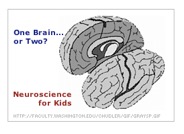Neuroscience of Narrative
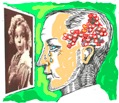
The Split Brain
Back Again (with Narrative and the Body)
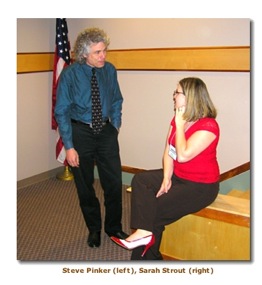

My paper attempts to explore the ways in which the narrative perspective in psychology might enter into a fruitful dialogue with evolutionary psychology despite the almost complete absence of recognition of each subarea in psychology by the other. I also suggest a kind of lingering Cartesianism that may affect both narrative and evolutionary perspectives. When I got home from the conference I did an awful lot of additional investigation of evolutionary models and biological research pertaining to narrative. The published paper expands significantly on each of my four points of contrast compared to what I had the chance to review at the conference. I got the paper out to the journal for review just in the nick of time and was really happy when the word came back of acceptance by the editors with only minor revisions.
Browsers of this blog can look over the scope of the articles in the special issue at this link and can download my own article in pdf format at this link. The article runs 17 printed pages.
Reference
- Hevern, V. W. (2008). Why narrative psychology can't afford to ignore the body (Special issue: Proceedings of the 2nd annual meeting of the NorthEastern Evolutionary Psychology Society). Journal of Social, Evolutionary, and Cultural Psychology, 2(4), 217-233. Available from http://www.jsecjournal.com/archive2-4.htm
To Sleep! Perchance To Dream
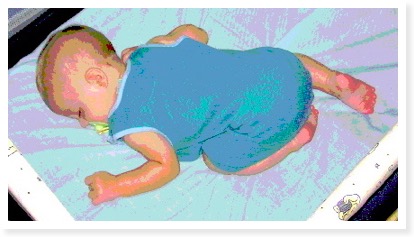
- An Active, Purposeful Machine That Comes Out at Night to Play (Benedict Carey) The lead article reviews the science of sleep and the history of research efforts to find out what sleep is all about.
- In Study of Human Patterns, Scientists Look to Bird Brains (Carl Zimmer)
- In the Dreamscape of Nightmares, Clues to Why We Dream at All (Natalie Angier)
- The Elderly Always Sleep Worse, and Other Myths of Aging (Gina Kolata)
- Sleep Drugs Found Only Mildly Effective, but Wildly Popular (Stephanie Saul)
- At Every Age, Feeling the Effects of Too Little Sleep (Jane E. Brody)
- Shh...My Child Is Sleeping (in My Bed, Um, With Me) (Tara Parker-Pope)
- From Faithful Dogs and Difficult Fish, Insight Into Narcolepsy (Ingfei Chen)
- Eyes Wide Shut: Thoughts on Sleep
Out of Body: Sensory Manipulation and the Experience of "Self"

In research that was just reported in latest issue of the journal, Science, two different teams of researchers at European universities have manipulated the visual and tactile sensory systems of study participants to induce the illusion that these persons were "out of their bodies". As Sandra Blakeslee reports in the New York Times (August 24, 2007):
The longer of the two studies (Lennenhager et al., 2007) offers this abstracted description of their findings:Using virtual-reality goggles, a camera and a stick, scientists have induced out-of-body experiences — the sensation of drifting outside of one’s own body — in ordinary, healthy people, according to studies being published today in the journal Science. When people gazed at an illusory image of themselves through the goggles and were prodded in just the right way with the stick, they felt as if they had left their bodies. The research reveals that “the sense of having a body, of being in a bodily self,” is actually constructed from multiple sensory streams, said one expert on body and mind, Dr. Matthew M. Botvinick, an assistant professor of neuroscience at Princeton University. Usually these sensory streams, which include vision, touch, balance and the sense of where one’s body is positioned in space, work together seamlessly, Dr. Botvinick said. But when the information coming from the sensory sources does not match up, the sense of being embodied as a whole comes apart. The brain, which abhors ambiguity, then forces a decision that can, as the new experiments show, involve the sense of being in a different body.
These results raise provocative questions about what it means to be a "self" and may actually move clinical researchers more deeply into an examination of neuroperceptual mechanisms in disorders such as schizophrenia. At the recent APA meeting in San Francisco, I heard a fascinating (and very difficult) paper by Louis Sass, Ph.D. of Rutgers (NJ) who presented a phenomenological model of schizophrenia, one which is rooted in defective processing of perceptual experience by the individual.Humans normally experience the conscious self as localized within their bodily borders. This spatial unity may break down in certain neurological conditions such as out-of-body experiences, leading to a striking disturbance of bodily self-consciousness. On the basis of these clinical data, we designed an experiment that uses conflicting visual-somatosensory input in virtual reality to disrupt the spatial unity between the self and the body. We found that during multisensory conflict, participants felt as if a virtual body seen in front of them was their own body and mislocalized themselves toward the virtual body, to a position outside their bodily borders. Our results indicate that spatial unity and bodily self-consciousness can be studied experimentally and are based on multisensory and cognitive processing of bodily information.
Target Articles: (A) Ehrsson, H. H. (2007, August 24). The experimental induction of out-of-body experiences. Science, 317(5841), 1048. (B) Lenggenhager, B., Tadi, T., Metzinger, T, & Blanke, O. (2007, August 24). Video ergo sum: Manipulating bodily self-consciousness. Science, 317(5841), 1096-1099.
Newspaper Report: Blakeslee, S. (2007, August 24). Studies report inducing out-of-body experience. New York Times (Online).
Other Citations: Sass, L. A., & Parnas, J. (2001). Phenomenology of self-disturbances in schizophrenia: Some research findings and directions. Philosophy, Psychiatry, & Psychology, 8(4), 347-356. [LMC Access]
Sass, L. A., & Parnas, J. (2003). Schizophrenia, consciousness, and the self. Schizophrenia Bulletin, 29(3), 427-444. [Abstract]
Hooking Teens on Cigarettes in a Flash

In a new clinical study reported in the July, 2007 issue of the Archives of Pediatric and Adolescent Medicine, the researchers followed 1246 sixth-grade students in Massachusetts for four years. By the end of their study, 217 of their participants reported inhaling while smoking. So, how many of these 10th graders could now be considered dependent on nicotine? Using the "Hooked on Nicotine Checklist" as the measure of loss of autonomy over tobacco and the ICD-10's definition of tobacco dependence, the results were startling. More than half these adolescents (N = 127; 54.5% of smokers) had lost their autonomy over tobacco use and 83 inhalers (38.2% of smokers) were fully tobacco dependent. Further, the speed with which autonomy loss was reached was extremely fast: 10% of these smokers had lost their autonomy within 2 days of beginning to smoke and 25% within the first month of first inhaling. Of those who were tobacco dependent, half had reached that condition by the time they were smoking just 46 cigarettes per month, i.e., one and a half cigarettes per day. The authors conclude
These data ought to speak loud and clear (though I know they won't) to teenagers and young adults who think that a couple of cigarettes every once in a while mean nothing. The ease with which tobacco use hooks its addicts is simply amazing.[t]he most susceptible youths lose autonomy over tobacco within a day or 2 of first inhaling from a cigarette. The appearance of tobacco withdrawal symptoms and failed attempts at cessation can precede daily smoking; ICD-10-defined dependence can precede daily smoking and typically appears before consumption reaches 2 cigarettes per day.
Target article: DiFranza, J. R., Savageau, J. A., Fletcher, K., O'Loughlin, J., Pbert, L., Ockene, J. K., McNeill, A. D., Hazelton, J., Friedman, K., Dussault, G., Wood, C, & Wellman, R. J. (2007). Symptoms of tobacco dependence after brief intermittent use: The development and assessment of nicotine dependence in Youth-2 study. Archives of Pediatric and Adolescent Medicine, 161, 704-710. [Link to abstract]
Newspaper report: Bakalar, N. (2007, July 31). Nicotine addiction is quick in youths, research finds. New York Times [Electronic version]
The image above is Copyright © Wellcome Images, but has been altered into a Derivative Work by the author by a colorization change.
Searching for the "Engram" and Finding It at UC-Irvine
Following upon the work of Ramon y Cajal and Sherrington, the Canadian neuropsychologist, Donald O. Hebb (1904-1985), disagreed with Lashley and argued for a mechanism by which memories could be localized, i.e., his proposal for the "Hebbian synapse" on the neuron and collections of such synapses across associated neurons in the form of "cell assemblies" (see Brown & Milner, 2003, for a longer appreciation of Hebb's contributions). For the past four decades, the focus for identifying Hebbian synapses has been undertaken under the overarching research concern for long-term potentiation (LPT), that is, the assumption that "information is storied in the brain as changes in synaptic efficiency..." and that "the location of storage, the engram of learning and memory, must therefore be found among those synapses which support activity-dependent changes in synaptic efficiency" (Bliss & Collingridge, 1993, p. 31).
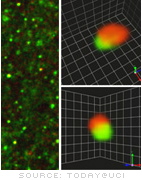
So, more than a century after Semon proposed a role for a physical trace in the brain's cell in the establishment of a memory, laboratory research has appeared to confirm this finding.the study shows that synaptic connections in a region of rats' brains critical to learning change shape when the rodents learn to navigate a new, complex environment. In turn, when drugs are administered that block these changes, the rats don’t learn, confirming the essential role the shape change plays in the production of stable memory...Working with advanced microscopic techniques called restorative deconvolution microscopy, the UC Irvine team found that the LTP-related markers appear during learning and are associated with expanded synapses in the hippocampus. Because the size of a synapse relates to its effectiveness in transmitting messages between neurons, the new results indicate that learning improves communication between particular groups of brain cells. (UC Irvine scientists, 2007, July 25).
Target article: Fedulov, V., Rex, C. S., Simmons, D. A., Palmer, L., Gall, C. M., & Lynch, G. (2007). Evidence that long-term potentiation occurs within individual hippocampal synapses during learning. Journal of Neuroscience, 27(30), 8031-8039. [Link to abstract]
Press release: UC Irvine scientists unveil the 'face' of a new memory [Press release]. (2007, July 24). Today@UCI. Retrieved July 31, 2007 from the UCI website: http://today.uci.edu/news/release_detail.asp?key=1638
References
Bliss, T. V. P., & Collingridge, G. L. (1993, Jan 7). A synaptic model of memory: Long-term potentiation in the hippocampus. Nature, 361(6407), 31-39.
Brown, R. E., & Milner, P. M. (2003). The legacy of Donald O. Hebb: More than the Hebb synapse. Nature Reviews Neuroscience, 4, 1013-1019. Retrieved July 31, 2007 from http://www.nature.com/nrn/journal/v4/n12/full/nrn1257_fs.html
Cherkin, A. (1966, Jan 15). Toward a quantitative view of the engram. Proceedings of the National Academy of Sciences of the United States of America, 55(1), 89-91.
Hebb, D. O. (1949). The organization of behavior: A neuropsychological theory. New York: Wiley. (Reprinted by Lawrence Erlbaum Associates, 2002.)
Semon, R. (1904). Die Mneme als erhaltendes Prinzip im Wechsel des organischen Geschehens. Leipzig, Germany: Wilhelm Engelmann.
Semon, R. (1921). The mneme. London: Allen and Unwin.
Wellcome Trust Opens Image Collection Online
Cannabis & Later Psychosis: The Lancet Meta-analysis
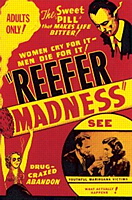
A new meta-analysis published in British medical journal, The Lancet, argues that the use of cannabis is not at all an innocent pleasure. Rather, in a review of the combined results of 35 population-based longitudinal observational studies of the relationship between the use of cannabis and psychiatric disorders in later life, the authors found an overall increased risk of 41% in the development of any psychosis among individuals who had used marijuana in the past. The summary of their findings reports:
These results were so persuasive that the editors of The Lancet editorialized as follows:There was an increased risk of any psychotic outcome in individuals who had ever used cannabis (pooled adjusted odds ratio=1·41, 95% CI 1·20–1·65). Findings were consistent with a dose-response eff ect, with greater risk in people who used cannabis most frequently (2·09, 1·54–2·84). Results of analyses restricted to studies of more clinically relevant psychotic disorders were similar. Depression, suicidal thoughts, and anxiety outcomes were examined separately. Findings for these outcomes were less consistent, and fewer attempts were made to address non-causal explanations, than for psychosis. A substantial confounding effect was present for both psychotic and affective outcomes.
So, has the question been settled? Is it clear that marijuana is a dangerous drug which can cause irreparable harm to its users? It would be stretching the scientific arguments advanced by Moore and her colleagues (2007) to use this study's findings as having settled this question in a definitive way. My reactions to this article include these thoughts:In 1995, we began a Lancet editorial with the since much-quoted words: “The smoking of cannabis, even long term, is not harmful to health.” Research published since 1995, including Moore's systematic review in this issue, leads us now to conclude that cannabis use could increase the risk of psychotic illness. ("Rehashing the evidence...," 2007)
- It is likely that using marijuana increases the risk of psychotic illness in later life for some small percentage of the population. And, since psychotic illness can be quite debilitating and tends to follow a chronic course, the danger may be substantial that some marijuana users are putting their later life in real jeopardy.
- Correlation, as our basic research theories tell us, can never prove causation. All of the studies examined by Moore et al. (2007) were correlational in nature. Further, the additional use of meta-analytic grouping techniques cannot turn correlational data into experimental data no matter how sophisticated the statistics. This means that, while the trends and the thrust of the data seems to make marijuana a very promising explanatory causal factor in the development of some of the psychoses that these research participants developed, such a link has not been conclusively demonstrated. And, while the gross odds ratio speaks of a 41% increased risk, the authors themselves acknowledge the impact of confounding and other variables in lowering the risk percentage in the studies they examined. Hence, we are left without a good estimate of what the actual increased risk might be.
- This last point is related to a fundamental set of questions about causality in the area of drug risk research. The primary question concerns how much the decision to use marijuana (in earlier life) and the development of a psychotic illness (in later life) might BOTH be causally related to an underlying third factor. Might it be possible that there is a genetic determinant or a genetic x environmental interactive determinant that could explain a large proportion of the relationship identified in this study? Alternatively, since we know that psychosis tends to emerge in adulthood rather than adolescence, might it be possible that pre-psychotic adolescents might be "self-medicating" or using marijuana to ward off their sense of an increasingly unstable or deteriorating psychological state and this would then serve to explain the sequence of drug use preceeding the appearance of tangible psychotic symptoms? Such questions demand further study.
Press release: Cannabis could increase risk of psychotic illness in later life by over 40 percent [Press release]. (2007, July 26). EurekAlert!.
References
Nordentoft, M., & Hjorthøj, C. (2007, July 28-August 3). Cannabis use and risk of psychosis later in life. The Lancet, 370, 293-294. (Commentary)
Rehashing the evidence on psychosis and cannabis [Editorial]. (2007, July 28-August 3). The Lancet, 370, 292.
====================
Update 7/30/07 11:30 pm
A respondent to Andrew Sullivan's excellent blog has posted a detailed argument why cannabis is not congenial to the mental health of many of its users. I found the posting persuasive and have posted a link to it here.
Tiny Brain Normal Life
![[MRI image of hydrocephalus]](page0_blog_entry2_1.jpg)
(Image taken from Wired Science blog)
The interior of the man's brain consisted mostly of fluid-filled ventricles with highly compressed brain tissue. Somehow, as the man grew up and the brain structure grew increasingly small, the brain was able to compensate. The man's IQ level was in the borderline range (full IQ = 75; verbal IQ = 84; performance IQ = 70), but permitted him to marry, father two children, and maintain a job as a government worker. (Read more at ScienceDirect).
Target article: Feuillet, L., Dufour, H., & Pelletier, J. (2007, July 21). Brain of a white-coloar worker. The Lancet, 370, 262.
